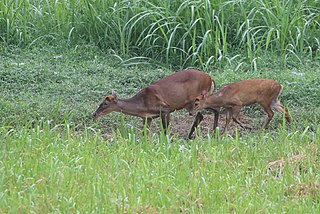
The southern red muntjac is a deer species native to Southeast Asia. It was formerly known as the Indian muntjac or the common muntjac before the species was taxonomically revised to represent only populations of Sunda and perhaps Malaysia. The other populations being attributed to this species are now attributed to Muntiacus vaginalis. Muntjacs are also referred to as barking deer. It is listed as Least Concern on the IUCN Red List.
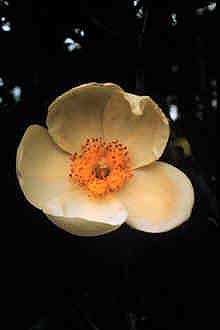
Gordonia is a genus of flowering plants in the family Theaceae, related to Franklinia, Camellia and Stewartia. Of the roughly 40 species, all but two are native to southeast Asia in southern China, Taiwan and Indochina. The remaining species, G. lasianthus (Loblolly-bay), is native to southeast North America, from Virginia south to Florida and west to Louisiana; G. fruticosa is native to the tropical rainforests of Central and South America, from Costa Rica to Brazil.

Myrica is a genus of about 35–50 species of small trees and shrubs in the family Myricaceae, order Fagales. The genus has a wide distribution, including Africa, Asia, Europe, North America and South America, and missing only from Australia. Some botanists split the genus into two genera on the basis of the catkin and fruit structure, restricting Myrica to a few species, and treating the others in Morella.

Terminalia elliptica is a species of Terminalia native to southern and southeast Asia in India, Nepal, Bangladesh, Myanmar, Thailand, Laos, Cambodia, and Vietnam. It is a prominent part of both dry and moist deciduous forests in southern India up to 1000 m.
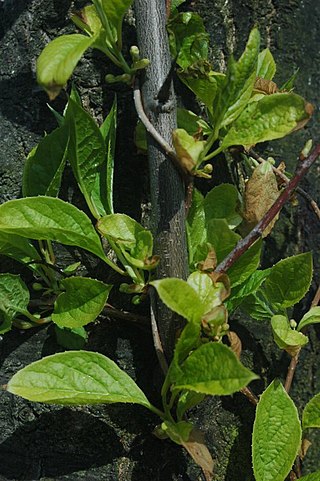
Schisandra chinensis, whose fruit is called magnolia berry or five-flavor fruit, is a vine plant native to forests of Northern China, the Russian Far East and Korea. Wild varieties are also found in Japan. It is hardy in USDA Zone 4. The fruits are red berries in dense clusters around 10 centimetres (3.9 in) long.

Spondias mombin, also known as yellow mombin, hog plum or amra, is a species of tree and flowering plant in the family Anacardiaceae. It is native to the tropical Americas, including the West Indies. The tree was introduced by the Portuguese in South Asia in the beginning of the 17th century. It has been naturalized in parts of Africa, India, Nepal, Bangladesh, Sri Lanka, The Bahamas, Indonesia, and other Caribbean islands. It is rarely cultivated except in parts of the Brazilian Northeast.

Quercus variabilis, the Chinese cork oak, is a species of oak in the section Quercus sect. Cerris, native to a wide area of eastern Asia in southern, central, and eastern China, Taiwan, Japan, and Korea.

Aquilaria sinensis is a species of plant in the family Thymelaeaceae. It is endemic to China. It is threatened by habitat loss. This medicinal plant is a source of fragrant wood, formed under a pathological condition, called Chen Xiang in Standard Mandarin, or chàhm hēung in Cantonese, or agarwood.

Rubus ellipticus, commonly known as ainselu, golden evergreen raspberry, golden Himalayan raspberry, or yellow Himalayan raspberry, is an Asian species of thorny fruiting shrub in the rose family. It's native range stretches from the Indian subcontinent to southern China and Indochina and the Philippines.

Pyrus pashia, the wild Himalayan pear, is a small to medium size deciduous tree of the small and oval shaped crown with ovate, finely toothed leaves, attractive white flowers with red anthers and small pear-like fruits. It is a fruit bearing tree that is native to southern Asia. Locally, it is known by many names such as batangi (Urdu), tangi (Kashmiri), mahal mol (Hindi) and passi (Nepal).

Syzygium nervosum is a species of tree native to tropical Asia and Australia, extending as far north as Guangdong and Guangxi in China and as far south as the Northern Territory of Australia. It was previously known as Cleistocalyx operculatus and also known as C. nervosum(DC.) Kosterm., and Eugenia operculataRoxb., 1832. It is a medium-sized tree of about 10 meters in height with pale brown bark and dull green leaves.

Catechin-7-O-glucoside is a flavan-3-ol glycoside formed from catechin.

Phulwara oil is extracted from seeds of Phulwara tree. Phulwara Trees are also known locally as Chiuri Trees, Kaeleb Trees, or Butter Nut Trees. Refined Phulwara Oil is marketed as Phulwara Ghee.
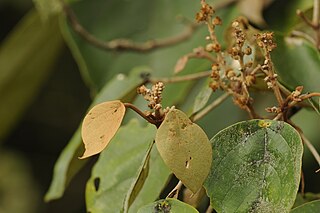
Mallotus tetracoccus, also known as the rusty kamala, is a species of flowering plant in the family Euphorbiaceae. It is a tree species found in parts of south Asia, typically occurring in the edges of tropical wet evergreen and semi-evergreen forests.
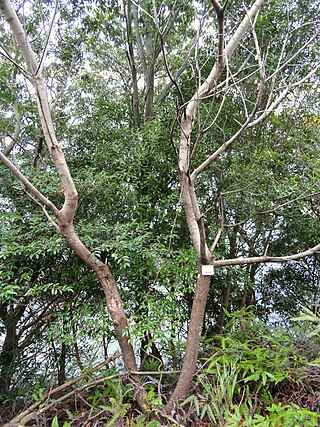
Brucea javanica is a shrub in the family Simaroubaceae. The specific epithet javanica is from the Latin, meaning "of Java". Other common names in English include Java brucea and kosam.

Tamarix dioica is a twiggy shrub or small tree that grows in saline habitats in western Asia. Common names include ghaz and khagal in Pakistan, lal jhau, urusia, ban jhau, nona-gach, urichiya in Bangladesh and nona jhau in the Sunderbans.

Spondias pinnata, sometimes also known as hog plum, is a species of tree with edible sour fruits. It is native to the Philippines and Indonesia, but has been widely naturalized in South Asia, Mainland Southeast Asia, Southern China, and the Solomon Islands. It belongs to the family Anacardiaceae. This species, among several others, has sometimes called the "wild mango" in other languages and was once placed in the genus Mangifera. It is found in lowlands and hill forests up to 1,200 m (3,900 ft).
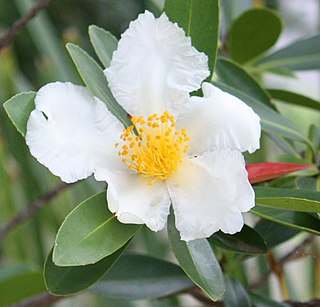
Polyspora axillaris is a species of evergreen tree or shrub that can grow up to 9 m tall. It has been given the name fried egg plant for its white and yellow flower. P. axillaris is found in southern China, including Hong Kong and Hainan. Is also grows in the wild in Taiwan and Vietnam, and is a garden tree all over the world.

A small tree with tortuous twigs, Dillenia pentagyna is a member of the family Dilleniaceae, and is found from Sulawesi to South-Central China to India and Sri Lanka. Material from the tree has some minor uses.

Casearia tomentosa, commonly known as the toothed leaf chilla, is a species of flowering plant in the family Salicaceae, native to the Indian Subcontinent and Myanmar. It is one of 1,000 species that can be found in the Salicaeceae family. Casearia tomentosa has various phytochemical and pharmacological properties that are used in the treatment of many illnesses. It is most notable used in the treatment of seafood poisoning, diabetes, ringworm, and snake bites. Other common names include Bhari, Maun, Churcha, Sonne bethe, and Kakoli based on the region where it is found.























